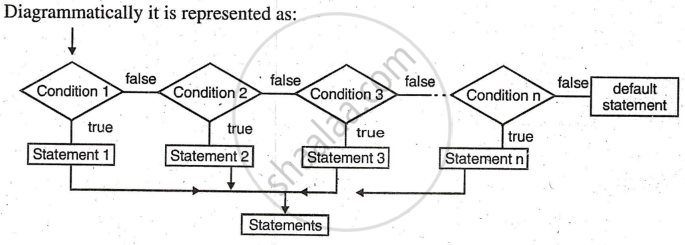Topics
Number Systems
Program Analysis
Introduction to C+ +
- Introduction to C++
- Character Sets
- Standard I/O Strems in C++
- Type Modifiers
- C++ Data Types
- Variables in C++
- Constants
- Compiler Tokens
- Operators in C++
- Comments in C++
- Scope and Visibility
- Control Statements
- Functions in C++
- Default Arguments
- Techniques used to pass Variables into C++ Functions
- Function Overloading
- Inline Functions
- Recursion
- Pointers in C++
- Arrays in C++
- References
- Type Conversion in Expressions
Visual Basic
- Introduction to Visual Basic
- One language Three Editions
- Study Of Integrated Development Environment (IDE)
- Visual Basic Programming
- Few Common Methods
Introduction to Networking and Internet
- Introduction to Networking and Internet
- Networking Terms and Concepts
- Types of Networks
- Network Security
- Network Configurations
- Network Applications
- Introduction
- Branching Statements
- Switch Statement
- Unconditional Control Structure (goto)
- Iterative (repetitive) Control Structures (Loops)
Control Statements
Control statements allow programmers to dictate which parts of a program execute and when. They resemble everyday decision-making and include two types: branching statements and loops. Branching executes a series of events based on a condition, while loops repeat a program section until a specified condition is met.

if, multiple if and nested if’s Statement
The first type of branching statement we will look at is the if statement. An if statement has the form:
Syntax:
if(condition)
{
//code to be executed if condition is true
}
else
{
//code to be executed if condition is false
}
You can have any number of if statements in your program. This is called multiple if. If one if condition is false, the compiler jumps to the next if statement and checks its condition.
Nested if else is an if else condition in another if else structure. 
Else-if ladder
Used for multipath decisions, all conditions are tested, and the corresponding block is executed when a condition is satisfied. If none are true, the else part is evaluated.

Switch statement
The switch statement, used instead of multiple if statements, allows grouping of if-else statements (else-if ladder) for conditions based on integral constants (integer or character). It is also known as a multiple-branch selection statement.
Syntax: switch(integer _val)
{
case value_1:
break;
.........
case value_n // code to execute if integer _val is value_n
break;
default:
}
The default clause is optional, but it is good programming practice to use it. The default clause is executed if none of the other clauses have been executed.
Unconditional control structure (goto)
So far, we've seen conditional flow control. For unconditional jumps, C++ uses the goto construct, which directs control to a labeled point in the program. Labels are valid variable names placed anywhere in the code. Although goto can create loops, using it is generally considered a bad programming practice.
for statement
The for loop is the most popular loop. It is widely used by programmers. It is also an entry controlled loop.
Syntax: for(initial_ value; test condition; step)
{
//Code to execute inside loop
}
Here initial_ value sets up the initial value of the loop counter.
test condition is the condition that is tested to see if the loop is executed again.
step describes how the counter is modified (incremented or decremented) on each execution of the loop. And code inside the for loop is executed until condition is satisfied
while statement
The simplest of all looping structures in C++ is while statement. It is also entry controlled loop.
Syntax : while( condition)
{
//code to execute
}
Here while is a keyword. The test condition is an expression which may return zero or non zero value. A non zero value is treated as true value and zero value as a false value. The body of loop is either an empty statement, a single statement or a block of statements
do - while Statement
Note: When you want to execute loop at least once, then instead of while, you can choose do ... while loop. In this loop, test condition is checked at last, so the loop is executed at least once, even though condition is not getting satisfied while entering the loop itself.
Syntax: do
{
// code to execute
} while(condition);
Use of break and continue & Aborting an Infinite Loop
The keywords break and continue control loop execution. break exits the loop, skipping the remaining statements and jumping to the next statement outside the loop. continue skips the remaining statements and moves to the next loop iteration.
An infinite loop runs endlessly without termination. Use break or exit(0) to stop it. Without such a mechanism, press Ctrl + C to interrupt the loop.
